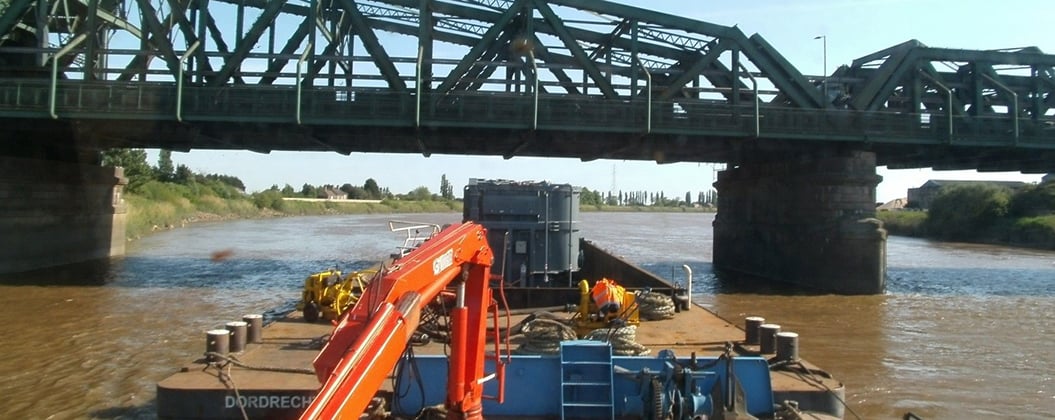Above: The Last Drager 19 passing under Keadby Bridge that crosses the River Trent near Althorpe and Keadby in North Lincolnshire.
The Port of Goole demonstrated is strengths recently with the handling of a large and unusual cargo.
Detailed planning ensured a 155t piece of project cargo has been safely delivered to Cottam. The incredible journey was made not by road, but by the network of waterways across North Lincolnshire, and involved precise navigation undertaken by Associated British Ports Marine Team.
Project cargo is the term used by the shipping industry to describe a large, heavy, critical piece of equipment or infrastructure. Having been originally shipped from Korea to Rotterdam, a 155t transformer, destined for Cottam Power Station in North Lincolnshire, was loaded onto the MV River Trader, for shipment across the North Sea to ABP’s Port of Goole. In Goole the transformer rendezvoused with the Lastdrager 19, a dumb barge that would take it along the waterways to its destination.
The barge had also been shipped from Rotterdam, arriving in the Port of Hull where local tug company, John Dean’s tugs, towed it to Goole using tugs Pushette and Gillian Knight. These tugs would also be used to manoeuvre the barge as it navigated its way to Cottam.
At West Dock South, Global Shipping Services carried out the heavy lift operation. Using a 1100t crane Global’s stevedores lifted the transformer off the River Trader, and loaded it onto a transporter, that drove it onto the Lastdrager 19. Based on the River Ouse the Port of Goole is located 80km inland from the North Sea. The port handles a wide range of different cargoes and specialises in heavy, awkward lifts, aided by the constant water level that enables heavy-lift working on most of the port’s berths. The 100-acre port handles around £800 million in UK trade each year, has a dedicated rail-freight terminal, and well-used canal connections to West and South Yorkshire.
Departing the Port of Goole on the ebb tide the three vessels sailed from Ocean Lock bound for the River Trent. With a timed layover at Blacktoft Jetty, the vessels set off again on the flood tide. Manoeuvred by the tugs, the team transitioned the Lastdrager 19 through the lower Trent, reaching Keadby Bridge, a critical part of the passage. Timing had to be perfect to ensure there was enough water height to remain afloat, and enough clearance under the bridge to pass under safely with a following tide. Careful manoeuvring of the barge was needed to allow for the strong tidal set on the approach and transit of Keadby Bridge. The barge passed under the M180 motorway and then waited for the tide to ease at Butterwick Jetty. The three vessels departed the jetty to begin transitioning the tight bends at Kelfield, Jenny Hurn, Stockwith and Morton Bight. The team arrived at Beckingham Wharf, Gainsborough in the late evening, nearly 12 hours after leaving the Port of Goole.
“Once again the Port of Goole has demonstrated the benefits of its unique inland location. With the professional partnership planning, executed by customers, specialists, ABP’s Marine Team and Hydrographers, and the Operations Team, all of which culminated in the successful shipping of nationally important piece of project cargo.” Simon Bird
Director of ABP Humber
The next stage of the journey was to transit the stone bridge at Gainsborough. This would be the lowest bridge on the passage and therefore a critical point in the planning process. Using the last of the ebb tide, the barge passed under successfully and continued its journey. The stone bridge marks the southern boundary of ABP’s Harbour Authority limits on the River Trent. The remaining part of the journey fell within the Canal and River Trust district.
Having navigated more tight corners such as Stoney Bight and Marton Hill, the Lastdrager 19 arrived at Cottam, nearly 36 hours after leaving Goole, testament to the complexity of the operation. Constant use of the tugs and mooring lines were needed to ensure the Lastdrager 19 maintained position, whilst the heavy lift trailer was discharged. The journey didn’t end there for the Lastdrager 19, with the team having already made the navigation plan for it to return to sea.


